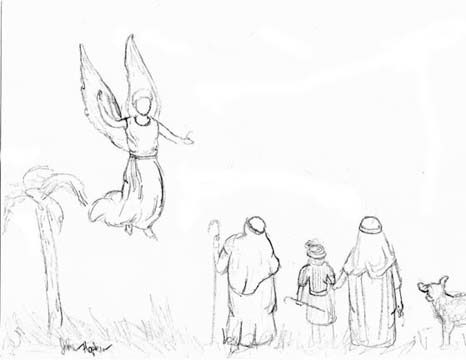
For the past few weeks (Part I here) (Part II here) I’ve been writing about the bible’s stories of the birth of Jesus by saying that while it’s common to combine the two distinct stories into one, there are really quite different accounts of the birth of Jesus as told by Matthew’s gospel and by Luke’s gospel in the New Testament. This week we’ll look at Luke’s account.
While Matthew wrote of a star, Magi and an angel appearing to Joseph, Luke tells of an angel coming to Mary, of shepherds, angels and a manger. No star. No Magi.
When children act out this story in pageants it’s common for three of them to play “innkeepers” who send Joseph and his pregnant wife Mary away. The third usually says something like “we have no room, but I’ll let you use our stable where the animals are.” Luke doesn’t write about these encounters; he just notes that Mary places Jesus in a manger “because there was no room in the place where travelers lodged.” While we might use the image of the three innkeepers as a lesson for our children to be welcoming and sympathetic, this was not Luke’s concern. He wanted to place Jesus in a feeding trough. The “manger” was indeed the trough where hay or grain was placed for animals to eat. Our English word when spoken by the French is their verb “to eat.” Jesus, as the early church believed, continued to be food for his followers as they ate his body under the form of bread in the Eucharist. And just like Matthew, Luke isn’t writing a history of Jesus’ birth, he’s writing to convince his generation of who the risen Jesus is: he is food given to nourish his followers to become lik him.
While Matthew has Joseph and Mary living in a house in Bethlehem, and later has them move to Nazareth because of King Herod’s persecution, Luke has them starting in Nazareth and going to Bethlehem because of Caesar’s census. This is no accident. Luke is reaching out to the gentile world and shows that God’s plan for salvation involves all people, not just the Jewish people. God cooperates with the pagan emperor and Luke is nudging his gentile readers to cooperate back by going along with God’s plan.
But he also appeals to his Jewish readers when he speaks of the angel coming to Mary — a recognizable occurrence in the old testament when God was revealing a special plan. The angels are also God’s messengers to the shepherds, who are a most unlikely group of first-witnesses to the birth of the messiah.
Shepherds were among the most unsavory people of the time. The fact that they lived in the fields and did not frequently bathe didn’t help. Besides smelling like sheep, they also were known to “lose” a sheep or two, that is, sell one of the owner’s sheep to someone else for some quick profit. So it was odd that angels should come to this group of unscrupulous characters and announce the birth of the messiah. Yet it connects perfectly with Jesus’ message that he came into the world to bring good news to the poor and the outcast. His entrance into the world as a naked baby in an animal stable is a symbol of the kind of God he was revealing — not one to ruthlessly rule with power, but one who humbly lives as one of us and who leads by loving example. For Luke, the humble beginnings of Jesus as experienced by marginal people foreshadows the continuing message that Jesus reveals to all.
Even though we often mix the two accounts together, when we look at each of the gospels separately, we can recognize the richness of the messages that each gospel writer wants to proclaim.
Now it’s our turn. I invite my readers who celebrate Christmas to pick up their bibles and read each of the stories and be open to what new message God wants to reveal to their hearts.
As the Christmas season is about to begin on December 24th, I wish all God’s love and blessings throughout the Christmas weeks ahead.
Get an early and original look at this column and all that the Levittown Tribune offers each week by subscribing here: http://antonnews.com/subscribe






























